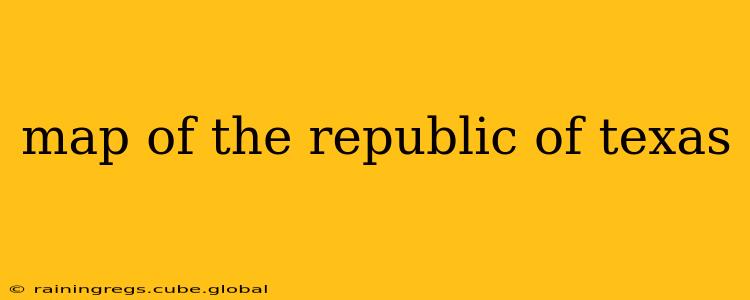The Republic of Texas, a brief but impactful chapter in American history, existed from 1836 to 1845. Understanding its geographical boundaries requires more than just a glance at a modern map; it necessitates exploring the complexities of its claims, disputes, and eventual annexation. This article will delve into the cartography of the Republic, answering common questions and clarifying its sometimes-ambiguous borders.
What did the map of the Republic of Texas look like?
The map of the Republic of Texas wasn't static. Its borders were constantly contested, shifting with military victories, diplomatic negotiations, and evolving claims. Generally, it encompassed a vast territory stretching from the Sabine River in the east to the Rio Grande in the west, and from the Gulf of Mexico in the south to a vaguely defined northern boundary, often claimed to be the 42nd parallel. This vast area included present-day Texas, parts of Oklahoma, Kansas, New Mexico, and Colorado. However, the actual control and effective governance of these areas varied significantly. Many maps of the time show the claimed territory, not necessarily the territory under effective control by the Texan government. These maps often reflected the aspirations and political maneuvering of the Republic more than the reality on the ground.
What were the disputed territories of the Republic of Texas?
The primary disputes centered around the northern and western borders. Mexico never recognized Texan independence, claiming the entire area as its own. The northern boundary, claimed by Texas as the 42nd parallel, was challenged by various Native American tribes and later by the United States, which had its own expansionist ambitions in the region. The western border, along the Rio Grande, was also a major point of contention with Mexico, resulting in ongoing conflict and contributing to the Mexican-American War. The eastern boundary, along the Sabine River, was relatively less contested.
How did the map of the Republic of Texas change over time?
The map changed through a series of treaties, military campaigns, and diplomatic negotiations. Initial maps reflected the territory won during the Texas Revolution. Subsequent treaties, such as those attempted with Native American tribes, aimed to solidify borders, but these often remained unstable. The ongoing conflicts with Mexico further complicated the cartographic representation of the Republic. The annexation by the United States in 1845 ultimately resulted in the most significant redrawing of the boundaries, leading to the modern borders of Texas and the resolution (at least temporarily) of many of the long-standing border disputes.
What was the significance of the Rio Grande as the western border of the Republic of Texas?
The Rio Grande's designation as the western boundary was a significant point of contention and a key factor leading to the Mexican-American War. Texas claimed the Rio Grande as its southwestern border, while Mexico insisted that the Nueces River formed the legitimate boundary. This disagreement over approximately 150 miles of territory fueled tensions between the two nations and ultimately led to armed conflict, culminating in the United States' victory and the subsequent acquisition of vast territories by the United States.
Where can I find old maps of the Republic of Texas?
Numerous historical societies, archives, and online resources hold collections of maps depicting the Republic of Texas. Searching online for "maps of the Republic of Texas" will yield numerous results, including digitized versions of historical maps. Libraries with strong Texas history collections are also excellent resources. Be aware that the accuracy and detail of these maps vary, reflecting the uncertain and contested nature of the Republic's boundaries during its short existence. Examining multiple maps from different periods provides a more complete picture of the evolving cartography of the Republic.
This exploration provides a deeper understanding of the complexities surrounding the map of the Republic of Texas. While a simple depiction might seem straightforward, the underlying historical context, territorial disputes, and evolving claims reveal a far richer and more nuanced story of the Lone Star Nation's geographical evolution.
